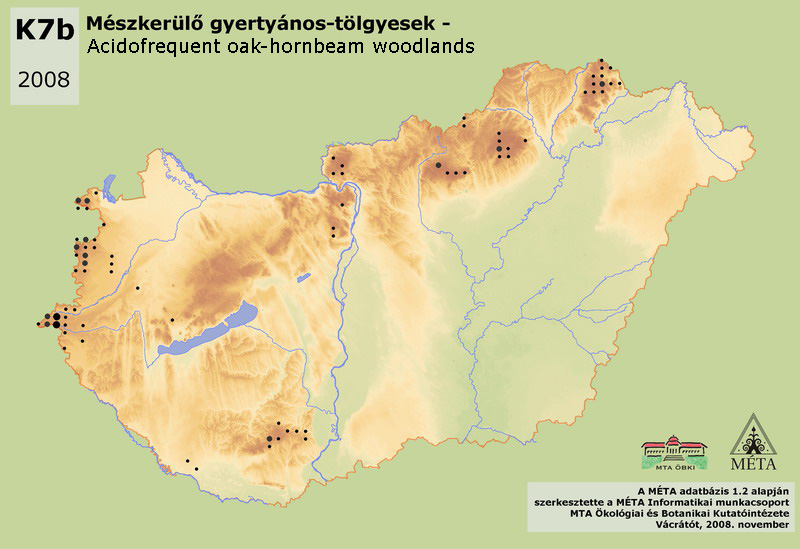MÉTA Program >>> Habitat distribution maps


K7b – Acidofrequent oak-hornbeam woodlands:
Submontane and colline, medium-high growing, frequently secondary forests, developed on acid bedrock and on eroded forest soils. They can be characterized with closed canopy layer, with the lack of shrub layer, and with the dominance of Quercus petraea, hornbeam and/or beech in the tree layer. The herb layer is composed of acidofrequent species [Luzula luzuloides, Deschampsia (Avenella) flexuosa, Vaccinium myrtillus, etc.], and by species of mesic deciduous forests in smaller amount. It is a rare habitat type; the total area is around 1300 ha. Most of the Hungarian occurrences (more than 1000 ha) are in Nyugat-Dunántúl (mainly Soproni-hegység, Kőszegi-hegység and its vicinity, Őrség, Vendvidék). There are smaller stands in the higher regions of the Északi-középhegység (150 ha, Börzsöny, Mátra, Bükk, Sátor-hegység, Heves-Borsodi-dombság) and in Mecsek (40 ha). It is very rare in the Dunántúli-középhegység (Bakony, Budai-hegység, Visegrádi-hegység). Former forest use (grazing, coppicing, litter gathering) played an important role in its evolution. Considering that the stands can be found on soils of secondary acidification, a few decades of protection can lessen or cease the acid character of the herb layer, and with this, that of the whole forest.
Molnár, Zs., M. Biró, J. Bölöni & F. Horváth (2008): Distribution of the (semi-)natural habitats in Hungary I.: Marshes and grasslands, Acta Botanica Hungarica 50 (Suppl): 59-105. >>> letöltés (5,4 MB, PDF)
MÉTA Program,
MÉTA Fotótár
MÉTA Élőhely-Ismereti Útmutató (ÉIÚ),
MÉTA Adatlap-Kitöltési Útmutató (AL-KÚ)
(C) MÉTA Informatika, 2005-2009,
MTA Ökológiai és Botanikai Kutatóintézete
K7b - Acidofrequent oak-hornbeam woodlands - Mészkerülő gyertyános-tölgyesek (HU)
Attachment
KV_EH_k7b_elterjedes_2.0.jpg 150.74 KB